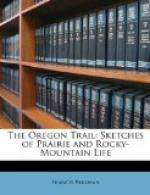We were now come to a part of the country where we were bound in common prudence to use every possible precaution. We mounted guard at night, each man standing in his turn; and no one ever slept without drawing his rifle close to his side or folding it with him in his blanket. One morning our vigilance was stimulated by our finding traces of a large Comanche encampment. Fortunately for us, however, it had been abandoned nearly a week. On the next evening we found the ashes of a recent fire, which gave us at the time some uneasiness. At length we reached the Caches, a place of dangerous repute; and it had a most dangerous appearance, consisting of sand-hills everywhere broken by ravines and deep chasms. Here we found the grave of Swan, killed at this place, probably by the Pawnees, two or three weeks before. His remains, more than once violated by the Indians and the wolves, were suffered at length to remain undisturbed in their wild burial place.
For several days we met detached companies of Price’s regiment. Horses would often break loose at night from their camps. One afternoon we picked up three of these stragglers quietly grazing along the river. After we came to camp that evening, Jim Gurney brought news that more of them were in sight. It was nearly dark, and a cold, drizzling rain had set in; but we all turned out, and after an hour’s chase nine horses were caught and brought in. One of them was equipped with saddle and bridle; pistols were hanging at the pommel of the saddle, a carbine was slung at its side, and a blanket rolled up behind it. In the morning, glorying in our valuable prize, we resumed our journey, and our cavalcade presented a much more imposing appearance than ever before. We kept on till the afternoon, when, far behind, three horsemen appeared on the horizon. Coming on at a hand-gallop, they soon overtook us, and claimed all the horses as belonging to themselves and others of their company. They were of course given up, very much to the mortification of Ellis and Jim Gurney.




